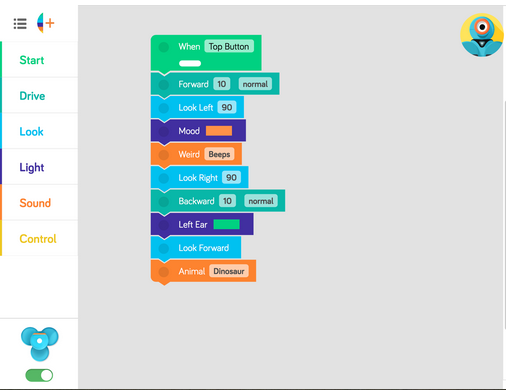Confession time, this has been a research interest for me, along with a number of colleagues, since around 2005. It started with undergraduate students - investigating teaching and developing problem solving skills as a first step developing programming skills through the use of LEGO-based robots and graphics based programming for undergraduate students. The main vehicle for developing the problem-solving skills has been LEGO Mindstorms robotics kits and series of gradually more challenging robot-based tasks.

Lawhead et al (2003) stated that robots “…provide entry level programming students with a physical model to visually demonstrate concepts” and “the most important benefit of using robots in teaching introductory courses is the focus provided on learning language independent, persistent truths about programming and programming techniques. Robots readily illustrate the idea of computation as interaction”. Synergies can be made with our work and those one on pre-object programming and simulation of robots for teaching programming as a visual approach to the teaching of the widely used programming language Java.
The main benefits that the students stated of this approach was they believe robots provide a method to visually and physically see the outcome of a problem. The approach taken the module has been visually-orientated. The appropriateness of this seems to be borne out by the student comments. Student satisfaction for a module based around this approach is over 92%. One of the comments made was that the linking of the problem-solving robot task and the programming assignment was liked. This feedback is similar to that reported by other authors when teaching programming using robots (Williams et al, 2003). There is enough scope in this approach to have different levels of complexity/functionality within an assignment task offering a basic ‘pass’ level for a particular task, but also the scope for those students that desire more of a challenge.
Reference
Lawhead PB, Bland CG, Barnes DJ, Duncan ME, Goldweber M, Hollingsworth RG,
Schep M (2003), A Road Map for Teaching Introductory Programming Using
LEGO Mindstorms Robots SIGCSE Bulletin, 35(2): 191-201.
Williams AB (2003) The Qualitative Impact of Using LEGO MINDSTORMS Robot
to Teach Computer Engineering IEEE Trans. Educ. Vol. 46 pp 206.
Publications
- Hill, G. and Turner, S. J. (2014) Problems First, Second and Third. International Journal of Quality Assurance in Engineering and Technology Education (IJQAETE). 3(3), pp. 88-109. ISSN: 2155-496 DOI: 10.4018/ijqaete.2014070104
- Turner S (2014) "Greenfoot in Problem solving and Artificial Intelligence" CEISEE 2014 University of Electronic Science and Technology of China, Chengdu China 24-25 April 2014. 2013
Turner S (2011) Neural Nets Robotics Workshop. Bot Shop! University of Derby, 28th October 2011.
Hill G, Turner S (2011) Chapter 7 Problems First Software Industry-Oriented Education Practices and Curriculum Development: Experiences and Lessons edited by Drs. Matthew Hussey, Xiaofei Xu and Bing Wu. ISBN: 978-1609607975 IGI Global June 2011 DOI: 10.4018/978-1-60960-797-5.ch007
- Turner S and Hill G (2010) "Innovative use of Robots and Graphical Programming in Software Education" Computer Education Ser. 117 No. 9 pp 54-57 ISSN: 1672-5913
- Turner S, Hill G, Adams J (2009) "Robots in problem solving in programming" 9th 1-day Teaching of Programming Workshop, University of Bath, 6th April 2009.
- Turner S and Hill G(2008) "Robots within the Teaching of Problem-Solving" ITALICS vol. 7 No. 1 June 2008 pp 108-119 ISSN 1473-7507
- Turner S and Adams J (2008) "Robots and Problem Solving" 9th Higher Education Academy-ICS Annual Conference, Liverpool Hope University, 26th August - 28th August 2008. pp. 14 ISBN 978-0-9559676-0-3.
- Adams, J. and Turner, S., (2008) Problem Solving and Creativity for Undergraduate Computing and Engineering students: the use of robots as a development tool Creating Contemporary Student Learning Environments 2008, Northampton, UK.
- Adams, J. and Turner, S., (2008) Problem Solving and Creativity for Undergraduate Engineers: process or product? International Conference on Innovation, Good Practice and Research in Engineering Education 2008, Loughborough, UK.
- Adams, J., Turner, S., Kaczmarczyk, S., Picton, P. and Demian, P.,(2008). Problem Solving and Creativity for Undergraduate Engineers: findings of an action research project involving robots International Conference on Engineering Education ICEE 2008, Budapest, Hungary.
- Turner S and Hill G(2007) Robots in Problem-Solving and Programming 8th Annual Conference of the Subject Centre for Information and Computer Sciences, University of Southampton, 28th - 30th August 2007, pp 82-85 ISBN 0-978-0-9552005-7-1
- Turner S (2007) Developing problem-solving teaching material based upon Microsoft Robotics Studio. 8th Annual Conference of the Subject Centre for Information and Computer Sciences, University of Southampton, 28th - 30th August 2007 pp 151 ISBN 0-978-0-9552005-7-1
- Turner S (2007) Developing problem-solving teaching materials based upon Microsoft Robotics Studio. Innovative Teaching Development Fund Dissemination Day 1st March 2007 Microsoft:London
- Turner S and Hill G (2006) The Inclusion Of Robots Within The Teaching Of Problemsolving: Preliminary Results Proceedings of 7th Annual Conference of the ICS HE Academy Trinity College, Dublin, 29th - 31st August 2006 Proceedings pg 241-242 ISBN 0-9552005-3-9
All opinions in this blog are the Author's and should not in any way be seen as reflecting the views of any organisation the Author has any association with.



